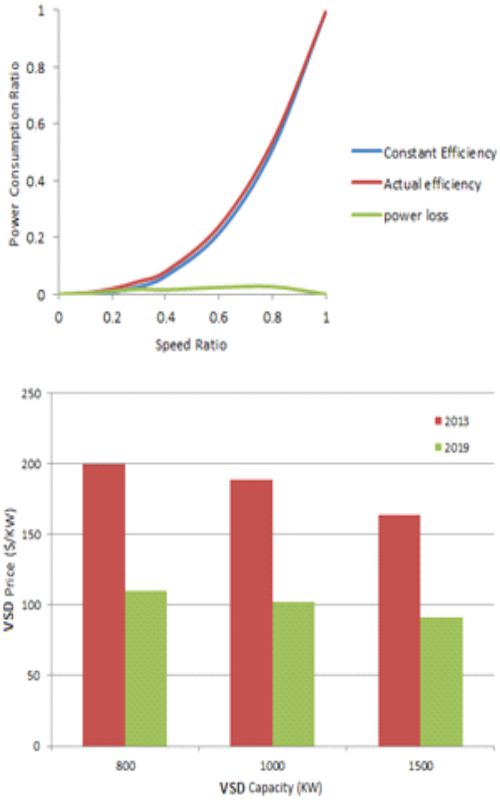EVALUATION OF VARIABLE SPEED DRIVES TO IMPROVE ENERGY EFFICIENCY AND REDUCE GAS EMISSIONS: CASE STUDY
Scientific paper
DOI:
https://doi.org/10.2298/CICEQ220318018SKeywords:
pump optimization, variable speed drives, energy efficiency, greenhouse gas emissionsAbstract
Variable speed drives are the most promising technique for reducing electric motors' energy consumption. This paper discusses energy savings by installing variable speed drives to control rotating equipment motors such as pumps, compressors, blowers, and fans in oil processing facilities. In addition to energy savings, variable speed drives will improve overall equipment efficiency, increase reliability, and reduce greenhouse gas (GHG) emissions. An energy audit was performed on a case study to investigate energy consumption for all electric motors. Technical and operational constraints for installing and operating variable speed drives were discussed. Installation requires adjustments in operation schedules and parameters to allow reducing energy consumption. The case study has illustrated how to calculate energy savings for pipelines, air coolers, air blowers for furnaces, pumps with variable flow rates, and reciprocating compressing systems. Variable speed drives were technically and economically accepted in air blowers, fans, and pumps. Energy consumption and GHG emission were reduced by 67%. The payback period for the whole project was less than one year. Meanwhile, it was not valid for reciprocating compressors as the payback period was 6.2 years.
References
E. Worrell, M. Corsten, C. Galitsky, Energy Efficiency Improvement and Cost Saving Opportunities for Petroleum Refineries, US Environmental Protection Agency, Washington, (2015) p. 66. https://www.energystar.gov/sites/default/files/tools/ENERGY_STAR_Guide_Petroleum_Refineries_20150330.pdf.
V.K. Arun Shankar, S. Umashankar, S. Paramasivam, H. Norbert, Appl. Energy 181 (2016) 495—513. https://doi.org/10.1016/j.apenergy.2016.08.070.
E. da Costa Bortoni, R.A. de Almeida, A.N.C Viana, Energy Effic. 1 (2008) 167—173. https://doi.org/10.1007/s12053-008-9010-1.
R. Saidur, S. Mekhilef, M.B. Ali, A. Safari, H.A. Mohammed, Renewable Sustainable Energy Rev. 16 (2012) 543—550. https://doi.org/10.1016/j.rser.2011.08.020.
J. Saxena, B.K. Choudhury, K.M. Agrawal, Encycl. Renewable Sustainable Mater. 3 (2020) 534—544. https://doi.org/10.1016/b978-0-12-803581-8.11010-0.
A.T. De Almeida, F.J.T.E. Ferreira, D. Both, IEEE Trans. Ind. Appl. 41 (2004) 136—144. https://doi.org/10.1109/icps.2004.1314992.
A.S. Tamez, MSc. Thesis, Utrecht University, (2019) P. 21. https://studenttheses.uu.nl/handle/20.500.12932/33582.
T. Walski, K. Zimmerman, M. Dudinyak, P. Dileepkumar, Proced. World Water Environ. Resour. Congr. 2003 (2003) pp. 1—10. https://ascelibrary.org/doi/abs/10.1061/40685(2003)137.
B. Coelho, A.G. Andrade-Campos, J. Hydraul. Re. 54 (2015) 586—593, https://doi.org/10.1080/00221686.2016.1175521.
R. Saidur, Renewable Sustainable Energy Rev. 14 (2010) 877—898. https://doi.org/10.1016/j.rser.2009.10.018.
US DOE, Adjustable Speed Drive Part-Load Efficiency, Washington, DC (2012) p. 1. https://www.energy.gov/sites/prod/files/2014/04/f15/motor_tip_sheet11.pdf.
A.J.H. Nel, D.C. Arndt, J.C. Vosloo, M.J. Mathews, J. Clean. Prod. 232 (2019) 379—390. https://doi.org/10.1016/j.jclepro.2019.05.376.
IPEICA, Electric Motors, https://www.ipieca.org/resources/energy-efficiency-solutions/efficient-use-of-power/electric-motors/ (accessed Jan. 09, 2021).
SIEMENS, Cost Considerations When Selecting Variable Frequency Drive Solution, SIEMENS, (2018) 1—10. https://assets.new.siemens.com/siemens/assets/api/uuid:064ed3aa-0d92-4c5b-9f7a-1aeb094518a8/cost-considerations-whitepaper1.pdf
G.E. Du Plessis, L. Liebenberg, E.H. Mathews, Appl. Energy 111 (2013) 16—27. https://doi.org/10.1016/j.apenergy.2013.04.061.
R. Carlson, IEEE Trans. Ind. Appl. 36 (2000) 1725—1733. https://doi.org/10.1109/28.887227.
D. Kaya, P. Phelan, D. Chau, H.I. Sarac, Int. J. Energy Res. 26 (2002) 837—849. https://doi.org/10.1002/er.823.
EA Abdelaziz, R. Saidur, S. Mekhilef, Renewable Sustainable Energy Rev. 15 (2011) 150—168. https://doi.org/10.1016/j.rser.2010.09.003.
EIA, EIA-State Electricity Profiles, https://www.eia.gov/electricity/state/unitedstates/ (accessed Jan. 10, 2021).

Downloads
Published
Issue
Section
License
Copyright (c) 2021 Mohamed Sadek, Rehab M. El-Maghraby, Mohamed Fathy

This work is licensed under a Creative Commons Attribution-NonCommercial-NoDerivatives 4.0 International License.
Authors who publish with this journal agree to the following terms:
Authors retain copyright and grant the journal right of first publication with the work simultaneously licensed under a Creative Commons Attribution License that allows others to share the work with an acknowledgement of the work's authorship and initial publication in this journal.
Authors grant to the Publisher the following rights to the manuscript, including any supplemental material, and any parts, extracts or elements thereof:
- the right to reproduce and distribute the Manuscript in printed form, including print-on-demand;
- the right to produce prepublications, reprints, and special editions of the Manuscript;
- the right to translate the Manuscript into other languages;
- the right to reproduce the Manuscript using photomechanical or similar means including, but not limited to photocopy, and the right to distribute these reproductions;
- the right to reproduce and distribute the Manuscript electronically or optically on any and all data carriers or storage media – especially in machine readable/digitalized form on data carriers such as hard drive, CD-Rom, DVD, Blu-ray Disc (BD), Mini-Disk, data tape – and the right to reproduce and distribute the Article via these data carriers;
- the right to store the Manuscript in databases, including online databases, and the right of transmission of the Manuscript in all technical systems and modes;
- the right to make the Manuscript available to the public or to closed user groups on individual demand, for use on monitors or other readers (including e-books), and in printable form for the user, either via the internet, other online services, or via internal or external networks.



